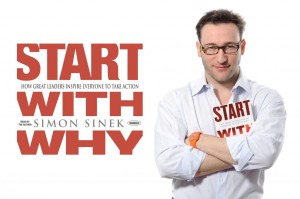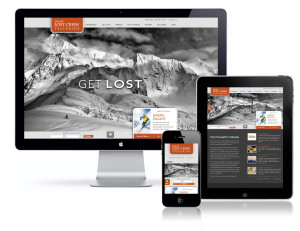Advertising, Behavioral Targeting, Buying Cycle, Content Marketing, Customer Experience, Data Analytics, Innovation, Interactive Marketing, Lead Generation, Optimization, Strategy
12 Secrets of the Human Brain to Use in Marketing
Advertising, Behavioral Targeting, Content Marketing, Conversion Optimization, Customer Experience, Inbound Marketing, Innovation, Mobile, Optimization, Web Design
5 Reasons Your Mobile Strategy Isn’t Working
I had a chance to catch up with fellow author, Simon Sinek to discuss his book called – Start With Why at the World Business Forum held in New York at Radio City Music Hall on October 7-8. My goal was to go a bit more in-depth on how to get started for B2B marketers, hope you enjoy the interview.
For those that follow this blog but are not yet familiar with your book Start with Why, give us little background.
A few years ago, I discovered that every single organization on the planet, even our own careers always function on the same three levels: what we do, how we do it, and why we do it. Everybody knows what they do. It’s the products we sell or the services we offer. Some know how we do it. It’s whatever you call it, your differentiating value proposition, your USP, the things that you think make you different or stand out from the crowd. But very few people and very few organizations can clearly articulate why they do what they do. But why I don’t mean to make money. That’s a result. I mean what’s your purpose, what’s your cause, what’s your belief, why does your company exist. And those that understand the why can clearly communicate it have an unbalanced amount of influence and success and loyalty in the marketplace with greater ability to innovate on all the rest of it.
Can every company have a why?
Not only can a big company have a why, every company does have a why. It comes from the founder. It’s the reason why they started the company. Those that are started from market opportunity, I read this article in a magazine and I realize that those tend to be very weak and they tend to not do well. But when a human being personally suffered or people close to them personally suffered something and they found a solution to whatever that problem was and that was the birth of the company, that’s a clear purpose.
Where’s the right place for a marketer to get started?
A good place to start is when companies are formed around real problems. It has to be born out of the cause of the founder. If it wasn’t a specific problem, then that founder has their own why, and the company is formed in their own cause. Virgin is Richard Branson. It’s the same thing. So you can usually go to the personality or the cause, the why of that founder.
How do you make it stick with the organization?
The why is the sticky part because it’s the visceral part. The why talks directly to the limbic brain, which is the part of the brain that makes decisions. It’s the emotion and feeling part of the brain. So when we start with why, that’s what makes it sticky. You can start with what and people might enjoy it for a moment. You describe the product, what it does, and it may or may not appeal to some people. But it’s the why that makes it interesting and makes people viscerally connected to it.
How do you make a strong why work in a B2B professional services organization?
The good news is that even consultants, accountants, or engineers are still human beings. So as much as they like to believe that all of their behavior is rational, it’s not. Otherwise they would only buy the cheapest product and they would never be loyal to anything. When the why is clearly communicated, it viscerally appeals to people, and they feel connected. And being a part of an organization with a clear sense of why becomes part of our self-identity. We wear the tee-shirt that they gave us at the company picnic. We don’t wear it to bed or paint the house. We wear it with pride and don’t want it to get dirty because it’s part of our self-identity.
I had a chance to catch up with Columbia Business School professor and fellow author, Rita McGrath to discuss her latest book called – The End of Competitive Advantage: How to Keep Your Strategy Moving as Fast as Your Business (Harvard Business Review Press, 2013). I also look forward to seeing her speak about this topic at the upcoming World Business Forum held in New York at Radio City Music Hall on October 7-8.
Tell us why sustainable competitive advantage really a failed notion these days?
Because it causes companies to do a lot of dysfunctional things like just focusing on the bottom line. If you’re looking for things to stay the same and you’re looking for reasons to keep just doing what you’re doing every day, then chances are that you’re going to be taken by surprise by the changes in the environment or changes in the competitive intensity of your business or things that are just not going to take you in a positive direction.
So the assumption that change is the weird thing and stability is the normal thing is something that causes a lot of companies to get taken by surprise. That’s why I argue that if you have this bias for sustainable (as in long-lasting, not as environmentally sustainable) it sets you up to make a lot of poor decisions in an environment that’s changing rapidly.
So how should companies think about and organize themselves to take advantage of short-term sustainable advantages?
The first big thing that companies need to do is to look at the elements of their business portfolio as an integrated whole, see that some things you’re doing that are driving today’s core business and that are going to continue to drive tomorrow’s core business. And you should keep doing them. Then you’ve got some things that you’re investing in which may be candidates to be part of the next generation core business, things that you’re doing today that could lead to a big, healthy business in the future. When Apple – just to take a common example – goes from making computers to making music players, but that’s an investment in one of these new platforms.
Then you’ve got to have things that you’re working on that are what I call “options,” which are small investments you’re making today that buy you the right but not the obligation to make some kind of future investments or take advantage of some future opportunity but that you don’t necessarily have to follow through on.
What does “good” in this new age look like?
If you look in the book, there’s this set of ten growth outliers that I think get a lot of this right. The kinds of things that they’re good at doing are letting their structure change as their business opportunities change. Things like making sure that leaders don’t get too calcified in any one role or any one spot. Making sure that they do things fast, they make decisions quickly. Their pace is quicker than a lot of other firms.
The problem with a lot of companies, particularly with respect to things like innovation, is that their structures were built to serve some of their business purpose in the past. So the structure they have today was built to help deliver yesterday’s business. When tomorrow’s business requires doing something different, you might need a different structure to go after it. But very often, the phrase I hear all the time is it “falls between the cracks” of the existing business. So what you want to be thinking about is building the right structure to deliver the business of the future.
What role can marketing play in helping to define a new opportunity? Is it the classic role that marketing plays, or is it something more?
I think it’s something different, and I think the world of marketing is about to undergo the most ginormous upheaval. And it has to do with the fact that on the one hand, the analytics that form the cornerstone of traditional marketing are really changing rapidly. When I was doing my PhD, it was all about conjoint analysis and co-word grouping and feature-function maps. Today with the advent of big data and the ability to combine data across many different, previous-unrelated databases, the onus on marketing to get really smart about how they use data and what discoveries they find from them is going to be very strong. There’s going to be a huge amount of pressure for that.
So I’ll give you a specific example. My colleague at Columbia, Oded Netzer did a big data project involving the use of the entire Edmunds database. It was a big, involved study, but he was able to use social media mentions from the Edmunds database to identify the General Motors push to rebrand the Cadillac to be more in line with a European luxury car and less like an American family car, which is how many people were beginning to think of it. He was able to demonstrate that that a particular set of investments actually got traction in the perception of the brand using only social media. I think that’s totally different than a lot of the tools that are in the marketing toolkit today.
What could this mean for the average marketer’s career? What does the ability to take advantage of these sorts of transient advantages mean for marketers?
I would suggest – don’t let yourself get stale. My watchwords are – if you come to work every day and all you’re doing is coming to work every day, you’ve got a long-term problem!
Moreover you’ve really got to know what’s going on out there. And I’ll give an example of a friend of mine at a big publishing company. She’d been let go and was meeting with a friend of mine who runs the learning and development department of this particular company. This marketing woman was saying I can’t get interviews. Or if she got interviews, she didn’t get offers because they want to know about things like search engine optimization, big data, social, and she had never had to learn any of that stuff. My friend meanwhile was completely outraged because she had arranged for online courses this woman could have taken advantage of, but she didn’t. The woman just came to work and did her job. As a consequence, she wasn’t even aware that a lot of this stuff was beginning to become a real for any company she considered going to.
So the point is I think you’d need to constantly be thinking about where are your skills in relationship to where the demand is going to be? Are you learning new things? Even if you don’t directly and immediately see the connection between your job and those skills, are you learning something new on a regular basis?
This week I moderated another Social Media Today webinar as part of their Best Thinker webinar series, this time on the topic of Transforming Events into Meaningful Experiences: Lessons in Real-Time Marketing. We had an esteemed panel consisting of Amber Quist, the Vice President of Brand Marketing and Communications at Spredfast; Greg Weiss, the Vice President / Business Leader of Social Media at MasterCard; and Adam Buchanan, the Social Media Manager for Cabela’s. This webinar was sponsored by Spredfast.
Amber set the stage with a discussion of Real-Time Marketing (RTM) and some examples of companies doing it right. When you hear RTM, you often think about the Super Bowl Oreo moment or this year’s Arby’s tweet at the Grammy’s, and we all agreed that is a form real-time marketing, but we want to widen the aperture a little on that definition and also talk about how brands are not only engaging in real-time moments, but also how they are using content in real-time in their owned media to engage their audiences and drive their brand forward. This set the stage nicely for Greg and Adam to discuss their companies success in RTM.
Adam then discussed the intersection of RTM with User Generated Content (UGC) and how that help drive the Cabela’s experience both online ad in-store. Cabela’s is leveraging UGC by “passing their customer the microphone,” because as Adam put it: “There’s a good chance your customer’s content is better than yours.” They leverage tweets and photos online to express the joy that fishing and hunting enthusiasts have when using their products. They also created a “digital brag board” in store to showcase some of the create UGC.
Greg took over and give us an inside view of how social experiences can be “priceless.” MasterCard’s theory was built on the idea that a brand that replies to a tweet can be worth more than years of advertising. They are currently running a campaign as the latest incarnation of their landmark “priceless” campaign, which started back in 1997 (17 years ago!), and it’s called “priceless surprises.” In this campaign they have surprises like Justin Timberlake showing up at your front door or surprise tickets to go see your favorite sports team playing a game. So far they have surprised over 60,000 loyal MasterCard customers!
Now, if you have ever been on a Social Media Today webinar before, you know they are very “participant-driven” and we love to ask your questions of our panelists. Many of the questions from our audience revolved around topics such as: How to handle the legal issues of using photos from customers? How best to organize for Real-Time Marketing? How does Real-Time Marketing work in a B2B environment?
If that piqued your interest, you may want to hear the replay of this webinar or review the slides: please click on this link. Otherwise we hope you will join us on another Social Media Today webinar! The next webinar is onAllocating Resources Across The Marketing Mix: Where to Spend Socially. Sign up for it, or view the schedule of upcoming webinars here.
The industry is constantly changing and it can be a challenge to keep up. How can you tell the difference between the skills that are necessary and those that are just hype?
Checkout Formstack’s new infographic on the “7 Skills Marketers Need to Succeed.” They studied the trends and crunched the numbers to help digital marketers prioritize their goals. You might be surprised by which marketing skills are worth developing.
Advertising, Facebook, Innovation, Search, SEO, Social Media, Social Networking, Strategy, Web Analytics
Where does Google+ fit into your B2B Marketing plans? [infographic]
Have you made Google Plus a part of your marketing strategy yet? If not, you could be missing out on a great opportunity to grow your audience. After all, it’s not every day that a social media website goes to great lengths to make your business more visible, but that’s exactly what you’ll get from Google’s services. By giving every plus profile a page rank, Google makes it easier for everyone to show up online in the search engine. And, with every comment, mention and +1 your content receives, you will rank higher on one of the most popular search engines in the world. If you don’t believe me, just check out the following infographic.
This handy guide will show you exactly why Google Plus is such a useful tool for businesses and B2B marketing. Even if you’re not sure how to get started, this infographic, provided by SmartVirtualPhoneNumber.com, will show you how to create an account and become active on the site. The more active you are, the more noticeable you will become. In addition, you’ll be able to take advantage of all the tools associated with Google’s social media service, including Google Hangouts.
If you’ve been looking for another way to reach out to potential business partners or create a larger following, Google + might just be able to provide the boost you’ve been looking for. Don’t wait any longer, make Google + a part of your business plans today!
Advertising, Applications, Business Intelligence, Content Marketing, Conversion, Conversion Optimization, Data Mining, Innovation, Interactive Marketing, Lead Generation, Lead Nurturing, Marketing, Online Advertising, Pay Per Click, ROI, Strategy
The Missing Link Between Media and Marketing
It’s apparent that there’s a missing vital component in the quest to modernize marketing. Today’s marketing organizations are aggressively modernizing, automating and adding more digitally centered marketing tactics as they focus on their mandate to discover prospects and create new customers. To meet the challenge, CMOs have turbocharged Marketing Ops teams and are building their “Marketing Clouds,” leveraging marketing automation to nurture prospects, adding CRM to manage pipeline and customer relationships, while spending millions on branded websites and social pages, coupled with billions on media to promote their offerings. We are not connecting that media investment, the prospects generated, nor their data, with our marketing systems and processes. Integration between the two is a critical missing link.
The prospect marketing effort, which is predominantly driven by third-party media investments in content syndication, search and advertising, is still very fragmented and, worse, seldom measured or optimized. Disconnected and unable to adequately track and optimize media spend, marketing organizations struggle with lead velocity, mixed data quality and a lack of ability to attribute results back to the source or measure ROI. This is a tough hit for marketing executives as they realize how much money they’re actually spending on media to create prospects—$40 billion+ on digital advertising alone in 2013, according to the IAB.
Here are 3 areas of focus for CMOs and marketing pros who are out to modernize their approach in order to drive a higher return on media and technology investment should consider:
- Integrate third-party media investment and data with marketing systems and processes. Today, engaging with the media community (publishers, affiliates and other sources) combined with the internal marketing processes necessary to get data into systems, requires numerous manual processes—hours of data scrubbing and lots of spreadsheets passed between media providers and marketing teams. A more efficient approach is to automate by integrating the prospect and lead data garnered from media campaigns and partners directly with your marketing automation system and/or your CRM. Ensuring the data is delivered directly into your current systems eliminates numerous manual, resource-intensive tasks.
- Validate prospect information in order to inject quality, actionable data, and thereby increase lead velocity and lower media costs. Once you decide to directly inject prospect data from your third party media sources, it becomes essential that the media-driven data you’ve paid for is validated, cleansed and formatted for your marketing systems (Eloqua, Marketo, Salesforce, Pardot, etc.). This not only ensures that you get what you paid for from your media investment, it also allows you to more rapidly get down to the business of nurturing and developing customers.
- “Close the Loop” to garner actionable insights that can be applied to optimize media campaigns and marketing programs. Today, we have the ability to gather data from every campaign we run but most of it we can’t and don’t act on. Whether you leverage banners, email, content syndication, telemarketing, search or a combination and whether you utilize cost per acquisition, lead, sale, click or incoming call, you need to analyze marketing performance data by media channel, media source, creative, content, offers and campaigns all in one place. Then you can more easily acquire insights that can be applied to optimize campaigns by focusing on higher performing tactics, redistributing media spend across the most successful media sources, and applying the resulting audience data to fine tune targeting parameters.
Taking action on the missing link is a necessity. If you are investing in media to generate prospects and acquire customers, be certain to connect those media programs with the rest of your marketing systems and process.
This post was written in collaboration with Integrate – learn more about Integrate at http://www.integrate.com
Advertising, Content Marketing, Conversion Optimization, Customer Experience, Design, Innovation, Interactive Marketing, Internet, Optimization, Web Design
4 Lessons from Responsive Design for CMOs
Responsive design brings a variety of benefits – both for brand marketers and the consumers interacting with content across multiple devices. According to data from a December 2012 study conducted by eConsultancy, nearly 70 percent of client-side marketers described their experience level with responsive design as “average” or better, and more than half of that group described their companies as “ahead of the curve” or “state of the art” when it came to the design technique.
As advanced as some brands and in-house digital marketers may believe they are in responsive design, there are still quite a few challenges that optimization experts and digital marketers must heed. Here are some lessons CMOs can use to get strategic in their approach while driving real, impact-filled growth to the bottom line.
Rule #1: Don’t Become Complacent
Since the mobile marketplace is extremely dynamic and the mobile consumer is ever changing, don’t become complacent just because you launched a responsive-design site. At the beginning of 2013, tablet users were already showing a higher conversion rate than desktop shoppers. Moreover, 20 percent of mobile users use it as their primary device. This means consumers are evolving more quickly than you may think, so closely monitor your analytics. In fact, companies like Gilt have seen a 100 percent increase in mobile users in a single year.
Rule #2: Always Be Refining
Continually develop and refine new design iterations that work seamlessly across multiple screen sizes and functionalities (e.g., touch, swipe). Being immersive is just as important as being intuitive. Pinch, swipe and zoom are features that smartphone and tablet users know and love. In the early days of responsive design, it was said that these were features that couldn’t be tapped into. With today’s more common blend of adaptive and responsive design, we know that this is not the case. Developers have touch-screen-specific controls at their disposal, and customization can be achieved through injection of JavaScript, for example. It’s important to strike the right balance between optimal performance (page-load time) and customization, as the two are interrelated.
Rule #3: Never Stop Testing and Learning
Always be testing and learning with your responsive-design site so that key information and functions are visible, prioritized and accessible to people regardless of what device they are using. Getting shoppers to move through the entire funnel – starting on the home page and moving to key product and landing pages all the way through the checkout process – is no easy feat. Each consumer, be it a first-time visitor or a longtime brand advocate, wants something different and unique from the checkout process. For a big-box apparel retailer, for example, free shipping can prove effective in rewarding high-value customers and cultivating loyalty among a brand’s average customers. This is where testing and learning play an integral role in pinpointing the optimal threshold for free shipping to boost online sales and grow the brand’s market share amid competitors. The data and insights delivered from a test-and-learn strategy could very well disprove brand assumptions and, in turn, generate the type of ROI brands seek such as higher average order value, as well as an increase in purchase conversions and overall revenue.
Rule #4: Leverage All Data
Even the most basic site analytics can reveal huge potential opportunities. Incorporating analytics early in the development of a responsive-design site is important. Set your responsive breakpoints you seek to track within your analytics solution and run a report for traffic to specific pages by device type. You’ll be able to glean a wealth of information about which areas of your site are seeing the heaviest tablet traffic, compared to areas with significant upticks in smartphone-only traffic. You’ll also be able to see which areas produce low traffic or poor conversions. This tactic can help you optimize the customer experience to drive customer engagement, loyalty, conversions and revenue consistently for the long haul.
In a company, the term “culture” is often defined by qualities such as an organization’s business values, overarching mission statement, operational style, working languages, technology and operating systems, personality traits and in-office habits. Basically I tend to think of a company’s culture as the delicate balance among those inexplicable qualities that make your employees do the things they do. It’s those traits that cannot always be written down on paper that often make employees and their company culture stand out amidst a crowd of “so-so” performers. And it’s often what keeps customers happy and coming back year and after.
Take, for example, a global footwear brand. This brand’s primary foothold may have been from brick-and-mortar stores around the U.S. But as consumers quickly ditch in-store shopping in favor of the speed, ease of use, convenience and massive array of product options made possible by online and mobile devices, a brand’s digital marketing culture matters, a lot. It can make all the difference in customer engagement and loyalty on one level. But most important, it can also very drastically impact actual sales figures and revenue across multiple channels. So let’s look at some of the prevailing digital “values” that could either help or hurt a brand’s bottom line.
The “other” dominates our attention. We spend our marketing dollars and resources in search of ways to “one-up” our competitors.
We see this a lot among brands. The marketplace is highly competitive these days. Consumer budgets are drastically lower, since the 2008 financial collapse. Attention spans and free time are often very limited. Consumers, in turn, demand much more from their experiences with brands, regardless of where these experiences occur and what devices they are using.
Because of these challenges, we often see brands looking to digital marketing to move the engagement and revenue needles in the right direction. But then they get stuck because their digital focus becomes all about showmanship and facing off in a tit-for-tat competition with others in their same space. What good will that approach do? Not much. It will only make your customers feel more frustrated, less appreciated and more unlikely to interact with your brand. If you can’t make every single interaction and experience customers have with your brand a positive, engaging and intuitive one—whether it’s in-store, online, mobile, social or email—you should expect to say goodbye to them relatively quickly.
We can no longer envision “big ideas” and creative marketing without the support of big data.
There once was a time when the “creative” process of branding and marketing was left solely to agencies and their teams of art directors, creative designers, copywriters and everyone else who spent a good portion of their days drawing and sketching out brand concepts and stories. On the other side of the proverbial “brand” table sat the numbers and analytics “geeks,” as they were often called. These teams would crunch numbers, run hundreds of equations, and compile long and arduous Excel® sheets.
Well, that divisive line between creative and data is no longer existent. To be a brand that’s challenging the status quo, inspiring consumers to smile, laugh, cry and even debate what’s acceptable, as well as getting consumers to spend more time and more money with them, we have to use data to support those “big ideas.”
No two consumers will ever want an identical experience, so we continually test and learn.
A recent poll by Korn/Ferry among senior executives indicates that 53 percent of them believe their companies should allocate budget to explore new marketing channels through a “test-and-learn” approach, in order to remain competitive; but half of the respondents feel that their marketing departments do not receive enough budget to do so.
Can chief marketing officers transform the way they market by simply employing a test-and-learn philosophy? Well, yes and no. Let me explain. If a brand is simply going to try a bunch of random “tactics” without any real reason or purpose behind them, there won’t be much value in it. Just look at how many brands these days are jumping headfirst into the responsive-design game. They’re doing it because they are being told by either the C-level executive team or the board of directors that mobile is where they need to be. So they go after a quick fix and rush into responsive design without any real thought, strategy or testing behind it. That’s a big mistake.
On the other hand, the real value of a test-and-learn digital culture lies in being patient, spending the time to analyze all of the data available (CRM, online, mobile and social), and identify what’s working and what’s falling through the cracks. That allows you to formulate a very calculated and strategic hypothesis and then test against that, until you can create an experience—be it online or mobile or social—that’s as relevant, seamless, easy to use and engaging as possible.
Search
Welcome to my blog, my name is Paul Dunay and I lead Red Hat's Financial Services Marketing team Globally, I am also a Certified Professional Coach, Author and Award-Winning B2B Marketing Expert. Any views expressed are my own.
Archives
- May 2024
- April 2024
- March 2024
- November 2023
- July 2023
- May 2023
- March 2023
- February 2023
- January 2023
- November 2022
- October 2022
- September 2022
- August 2022
- July 2022
- June 2022
- April 2022
- February 2022
- January 2022
- December 2021
- November 2021
- October 2021
- September 2021
- August 2021
- July 2021
- June 2021
- May 2021
- March 2021
- December 2020
- October 2020
- September 2020
- August 2020
- May 2020
- April 2020
- January 2020
- March 2019
- December 2018
- October 2018
- September 2018
- August 2018
- May 2018
- April 2018
- January 2018
- November 2017
- May 2017
- March 2017
- December 2016
- November 2016
- October 2016
- September 2016
- August 2016
- March 2016
- February 2016
- January 2016
- December 2015
- November 2015
- October 2015
- September 2015
- August 2015
- July 2015
- June 2015
- May 2015
- April 2015
- March 2015
- February 2015
- January 2015
- December 2014
- November 2014
- October 2014
- September 2014
- August 2014
- July 2014
- June 2014
- May 2014
- April 2014
- March 2014
- February 2014
- January 2014
- December 2013
- November 2013
- October 2013
- September 2013
- August 2013
- July 2013
- June 2013
- May 2013
- April 2013
- March 2013
- February 2013
- January 2013
- December 2012
- November 2012
- October 2012
- September 2012
- June 2012
- May 2012
- April 2012
- March 2012
- February 2012
- January 2012
- December 2011
- November 2011
- October 2011
- September 2011
- August 2011
- July 2011
- June 2011
- May 2011
- April 2011
- March 2011
- February 2011
- January 2011
- December 2010
- November 2010
- October 2010
- September 2010
- August 2010
- July 2010
- June 2010
- May 2010
- April 2010
- March 2010
- February 2010
- January 2010
- December 2009
- November 2009
- October 2009
- September 2009
- August 2009
- July 2009
- June 2009
- May 2009
- April 2009
- March 2009
- February 2009
- January 2009
- December 2008
- November 2008
- October 2008
- September 2008
- August 2008
- July 2008
- June 2008
- May 2008
- April 2008
- March 2008
- February 2008
- January 2008
- December 2007
- November 2007
- October 2007
- September 2007
- August 2007
- July 2007
- June 2007
- May 2007
- April 2007
- March 2007
- February 2007
- January 2007
- December 2006
- November 2006
- October 2006
- September 2006
- August 2006
- July 2006
- June 2006
- May 2006
- April 2006
- March 2006












